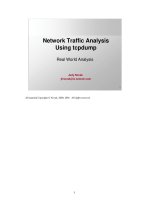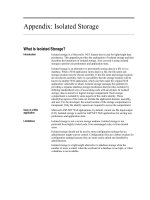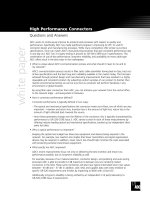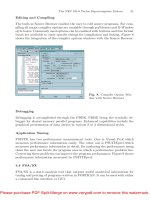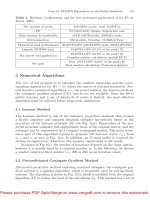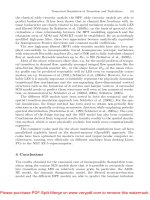Tài liệu High Performance Connectors docx
Bạn đang xem bản rút gọn của tài liệu. Xem và tải ngay bản đầy đủ của tài liệu tại đây (49.32 KB, 4 trang )
white paper
High Performance Connectors
ADC works to continuously improve its products and processes with respect to quality and
performance. Specifically, ADC has made significant progress in improving its UPC SC and FC
connector design and manufacturing processes. While many competitors offer similar out-of-box
specifications, none can match ADC’s manufacturing processes that give consistent performance day
in and day out. ADC has 3 rd party testing in process to GR-326-CORE Issue 3 specifications. This
combination of out-of-box performance, long-term reliability, and availability on every cable type
ADC offers result in the best value in the marketplace.
• What is unique about ADC’s connectorization process and what should it mean to me and to
my network?
ADC’s connectorization process results in fiber optic cable assemblies having best-in-class, best out-
of-box specifications and the best long-term reliability available in the market today. This has been
achieved through product design and manufacturing improvements that have resulted in a highly
repeatable and consistent product. By subjecting random samples of our product to harsher than
real-life environmental testing we can be sure that our products will perform flawlessly in any
environment or global location.
By using fiber optic connectors from ADC, you can enhance your network from the central office
to the network edge – and everywhere in between.
• How is connector performance defined?
Connector performance is typically defined in two ways:
– The optical and mechanical specifications the connector meets out-of-box; two of which are very
important – insertion and return loss. Insertion loss is the amount of light lost, return loss is the
amount of light reflected back towards the source.
– How these parameters change over the lifetime of the connector; this is typically characterized by
performance to GR-326-CORE Issue 3. ADC strives to excel in each of these measurements by
offering industry leading optical and mechanical specifications, backed up by independent third
party test data.
• Why is optical performance so important?
Keeping the optical loss budget low drives less equipment and devices being required in the
network. For example, low insertion loss implies that fewer transmitters and signal regeneration
devices may be required. In addition, lower return loss should help minimize the costs associated
with protecting sensitive transmission equipment.
• What exactly has ADC improved?
ADC’s recent improvements focus not only on delivering the best insertion and return loss
performance possible, but on long-term reliability as well.
For example, because of our material selection, connector design, and polishing and auto-tuning
processes ADC is able to provide 0.2 dB maximum IL between any two randomly mated
connectors in the field. These same connectors will also have typical intermated return loss values
between –53 dB and – 57 dB. In addition, ADC tests and supplies data with every endface to
specific GR-326 requirements and finishes by inspecting at 400X with a blue LED.
Additionally, long-term reliability is being verified by an independent 3 rd party laboratory to
GR-326-CORE Issue 3 requirements.
Questions and Answers
2
• What do you mean by tuning?
Tuning is the aligning of the connector ferrule such that any offset from nominal position of the fiber
end is aligned within an angular tolerance zone around a key feature on the connector body. This
offset would be in the same direction on all connectors and the insertion loss between connector pairs
would be minimized.
Tuning is a process by which the fiber core, the portion that transmits the light, is always located in the
same relative position. Using a clock as an analogy, tuning the fiber always orients the core between
10 and 2 o’clock positions; a non-tuned fiber connector does not. Having the fiber cores in the same
relative position means that they will be most closely aligned and insertion and reflectance losses will
be minimized.
• What is a “tunable connector”?
A tunable connector has a mechanism for rotating the ferrule in the connector body and locking it
into a given position. The connector is mated with a special tuning cable, the insertion loss at a
particular ferrule position is tested, the ferrule is rotated to the next position and tested again. Once all
the possible ferrule positions are tested, the ferrule is rotated and locked into the position that had the
lowest insertion loss.
• How does tuning improve insertion loss performance?
Tuning decreases insertion loss by improving the alignment of the fiber cores in mated pairs. The
accuracy of the tuning process has a direct affect on randomly intermated connector performance and
is improved through an automated process.
• What is the typical performance of un-tuned mated connectors in the field?
Typical performance of non-tuned mated connectors in the field is very supplier dependent, but from
ADC the average is around 0.2 dB. Depending on the quality of a given supplier’s process and
controls, maximum insertion loss can easily be in excess of 0.8 dB.
• What happens to performance when an improved tuned ADC connector is mated to a previous
generation ADC or non-ADC/non-tuned connector?
In general, ADC’s improved connector should have a neutral effect when mated to a previous
generation or non-ADC connector. However, performance will be optimized when two ADC improved
connectors are mated together.
• What happens to performance when an improved tuned ADC connector is mated to a non-ADC
tuned connector?
In general, the optical performance should be equivalent to mating two tuned ADC connectors
together. However, tuning is only part of the story. Consistent and precise end-face geometry is equally
important to maintaining this level of optical performance over time and in various operating
environments.
• How is measuring return loss in the factory different than measuring in the field?
The factory measures light lost coming through a single connector but the field is concerned with light
reflected back upstream through a mated pair interface.
• What are sources of return loss in fiber optic connections:
Fiber optic connectors are produced by polishing their endfaces to create a smooth domed shape. If the
shape or endface geometry is precisely controlled, the result will be physical contact between fiber cores
when two connectors are mated together. The polishing process creates a very small damaged layer at
the tip of the fiber that has a higher index of refraction (index layer) than the glass before the damaged
layer. Since reflections in optical fiber are caused by changes in index of refraction, it is the index layer
that causes the return loss associated with a mated pair of connectors.
3
• What are the sources of insertion loss in fiber optic connections:
– Transverse misalignment: Lateral mismatching of fiber optic core; increases with the square of
the distance between the centers of the cores; sources include ferrule, fiber and fiber through
hole concentricity
– Longitudinal misalignment: Occurs in the axial direction of the fiber; logarithmic function of endface
separation; sources include high apex offset, fiber withdrawal in a ferrule, mechanical separation of
ferrules under load
– Angular misalignment: Occurs if ferrule inside diameter runout becomes large
• What is ADC’s core alignment process?
ADC has chosen to utilize an automated as opposed to manual tuning process. This process relies less
on human intervention, giving more accurate and consistent core locations, and dramatically reducing
the potential for damage to the end-face.
• Why was this alignment process been chosen?
ADC stands behind its product, and we want product going into the field to perform exactly as we
advertise. Many of our competitors may manually tune their connectors and save a few cents in the
process. ADC doesn’t want to cut corners when it comes to delivering customers the world class quality
and performance they demand and expect.
• What are the benefits of endface geometry improvements?
Consistent endface geometry gives more consistent core to core contact under all operating conditions
(temperature swings, humidity, etc) and gives a good seal to prevent debris from
migrating to the core when in operation. Improved endface geometry is indicative of a very repeatable,
high quality manufacturing process. ADC measures and provides data to each of
the following measurements:
– Apex Offset to < 50 microns
– Fiber Recess to +/- 50 nanometers
– Radius of Curvature to 10-25 millimeters
• How do apex offset, fiber recess, and radius of curvature consistency affect IL and RL?
These parameters must all be within the ranges specified above in order for core to core contact to be
maintained under all operating conditions. ADC controls these very precisely and provides the actual
measurement with each UPC SC, FC, and LX.5 ? end shipped.
For example, apex offset measures the location of the ‘dome’ produced during the polishing process.
One wants the ‘dome’ locations to line up when mating to another connector; this serves as the
foundation for permitting core to core contact.
Fiber recess is also important because when two extremely high, protruding fibers are mated, they
induce stress on the fiber that can degrade performance over time. In the same light, two very recessed
fibers may lose contact if the temperature or humidity changes; air gaps cause significant reflectance.
Lastly, radius of curvature is a measure of how ‘flat’ or ‘pointed’ the shape of the endface is. It works in
tandem with apex offset and fiber recess to make certain the two fiber cores come in proper contact
and remain that way.
ADC Telecommunications, Inc., P.O. Box 1101, Minneapolis, Minnesota USA 55440-1101
Specifications published here are current as of the date of publication of this document. Because we are continuously improving our products, ADC
reserves the right to change specifications without prior notice. At any time, you may verify product specifications by contacting our headquarters
office in Minneapolis. ADC Telecommunications, Inc. views its patent portfolio as an important corporate asset and vigorously enforces its patents.
Products or features contained herein may be covered by one or more U.S. or foreign patents. An Equal Opportunity Employer
1247304 10/02 Original © 2002 ADC Telecommunications, Inc. All Rights Reserved
Web Site: www.adc.com
From North America, Call Toll Free: 1-800-366-3891 • Outside of North America: +1-952-938-8080 Fax: +1-952-917-3237
For a listing of ADC's global sales office locations, please refer to our web site.
• What are the industry standards for endface visual inspection workmanship?
At present, there is a draft International Electrotechnical Commission (IEC) visual inspection standard
and the beginning of documentation by the Telecommunication Industry Association (TIA). There are,
however, no published industry standards with which to compare the criteria and test methods. ADC
has therefore chosen a very stringent method to which we hold ourselves accountable.
• How does ADC measure endface visual inspection workmanship?
ADC performs an endface workmanship inspection after the polishing process using 400x magnification
(suggested standards currently call for 200x or greater), a blue light which illuminates the surface
making defects more detectable, and a camera with a video display. Defects are classified and measured
by an operator according to defect type, size and location. ADC has established an endface
workmanship standard that requires no defect to be viewed at 400x magnification within the fiber core
region or within a 62.5 micron diameter region around the fiber core.
• Why is visual inspection important?
Defects such as scratches, pits, cracks, chips, loose and fixed contamination on the endface negatively
impact IL/RL.
• Why is the location of a defect important?
There are zones on the endface that have an increased risk of performance problems caused by defects.
Because it guides the light in the fiber, defects in the core area of the fiber directly affect the amount of
light transmitted and reflected.
• So what makes ADC’s process and products better?
First, ADC has integrated manufacturing and measurement techniques that produce an extremely
consistent product. By focusing on SPC (statistical process control) ADC can make product day in and
day out that is essentially identical. This translates to flawless performance in the field, no matter which
two connectors end up mated together.
Second, this level of performance on UPC SC and FC connectors is now the ADC standard. This
ensures that ADC is able to continue supporting our customers with the level of service they have
come to rely on.
Third, this level of performance on UPC SC and FC connectors is available on every cable type ADC
offers – from single fiber patchcords to 216 count ribbon and stranded IFC cable.
• Why has Telcordia tightened optical and mechanical performance requirements with GR-326-CORE
Issue 3?
Telcordia receives input from a consortium of telecomm engineers representing a wide spectrum of
ADC’s customers. ADC also has engineering representation on this consortium. These engineers have a
vested interest in ensuring that network components are continually improving in order to keep pace
with network requirements. By continually raising the bar, this consortium ensures that the supplier base
invests in both process and product improvement.

